The Sandy Bridge Preview
by Anand Lal Shimpi on August 27, 2010 2:38 PM ESTAdobe Photoshop CS4 Performance
To measure performance under Photoshop CS4 we turn to the Retouch Artists’ Speed Test. The test does basic photo editing; there are a couple of color space conversions, many layer creations, color curve adjustment, image and canvas size adjustment, unsharp mask, and finally a gaussian blur performed on the entire image.
The whole process is timed and thanks to the use of Intel's X25-M SSD as our test bed hard drive, performance is far more predictable than back when we used to test on mechanical disks.
Time is reported in seconds and the lower numbers mean better performance. The test is multithreaded and can hit all four cores in a quad-core machine.
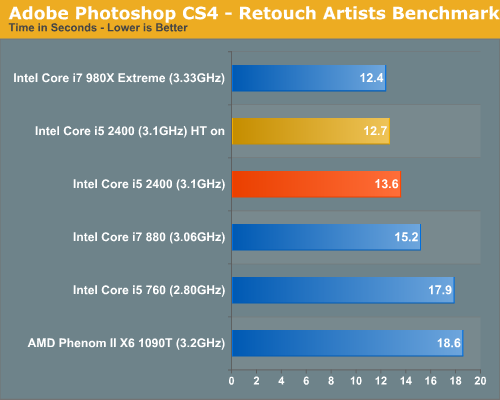
Right off the bat Sandy Bridge is killer. In our Photoshop test it’s faster than its closest quad-core price competitor, faster than its identically clocked Lynnfield, faster than AMD’s fastest and loses out only to Intel’s $999 Core i7 980X. That being said, it only takes about 9% longer to complete our benchmark than the 980X.
DivX 6.5.3 with Xmpeg 5.0.3
Our DivX test is the same DivX / XMpeg 5.03 test we've run for the past few years now, the 1080p source file is encoded using the unconstrained DivX profile, quality/performance is set balanced at 5 and enhanced multithreading is enabled:
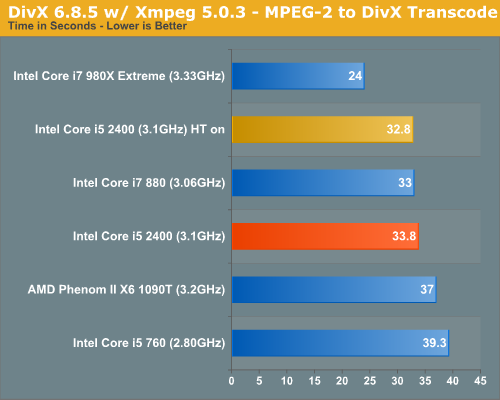
While not the most stressful encoding test, it’s still a valid measure of performance and once again, Sandy Bridge is faster than all. In this case we’re faster than the Core i5 760 (~16%) and just behind the Core i7 880. Clock for clock there's not a huge improvement in performance here (HT doesn't seem to do much), it's just a better value than the 760 assuming prices remain the same.
x264 HD Video Encoding Performance
Graysky's x264 HD test uses the publicly available x264 encoder to transcode a 4Mbps 720p MPEG-2 source. The focus here is on quality rather than speed, thus the benchmark uses a 2-pass encode and reports the average frame rate in each pass.
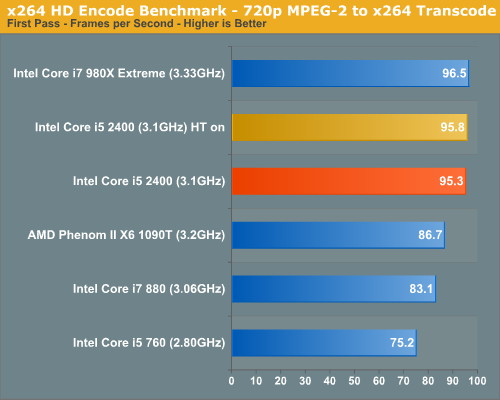
Lightly threaded performance is much improved - the 2400 is 14.6% faster than the Core i7 880.
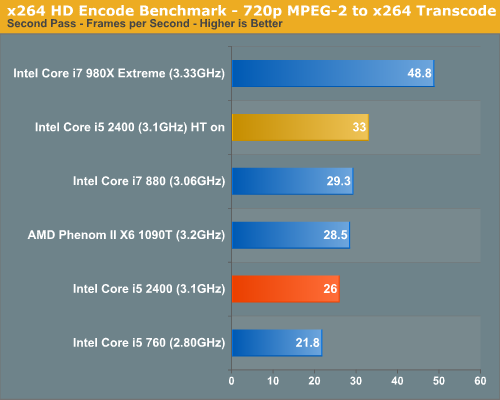
The actual encoding pass favors more threads, so we see a big improvement over the 760 (19%) but it falls short of the Core i7 880. Turn HT on and we get a 12.6% improvement over an identically clocked/configured Lynnfield.
Note that CPU based video encoding performance may not matter if Intel implemented a good video transcode engine in Sandy Bridge.
Windows Media Encoder 9 x64 Advanced Profile
In order to be codec agnostic we've got a Windows Media Encoder benchmark looking at the same sort of thing we've been doing in the DivX and x264 tests, but using WME instead.
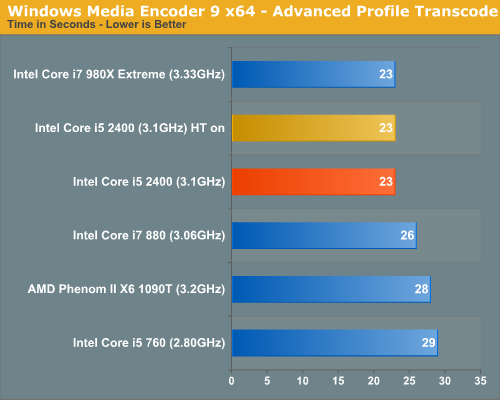
Performance in WME rarely scales anymore. Our benchmark doesn’t scale well beyond 4 cores and the only hope for performance are increases in clock speed or IPC. Sandy Bridge delivers the latter.
A 20% increase in performance vs. the similarly clocked 880 in a test that doesn’t scale with anything but IPC tells you a lot. Compared to the Core i5 760, Sandy Bridge is 26% faster.










200 Comments
View All Comments
starx5 - Tuesday, September 7, 2010 - link
And why didn't you ran 2560x1600(or higher resolution like eyefinity) benchmark either?Is this because sandybrige is not that good?
wut - Friday, September 10, 2010 - link
So you're expecting eyeinfinity out of a single integrated graphics connection out the back of a motherboard?Are you okay?
gundersausage - Tuesday, October 26, 2010 - link
i7-950 vs i7-2500K... So which will be faster and a better gaming chip? anyone?WillyMcNilly - Thursday, October 28, 2010 - link
Fantastic preview! I am definetly getting sandy bridge now. Apparently the Gigabyte P67-UD7 will have a geforce n200 chipset and support full 16X/16X sli AND crossfire! It will make a significant upgrade from my Phenom 2 and I cannot see myself waiting for bulldozer which has apparently been delayed (gee what a surprise!) until Q4 2011.Chrisch - Wednesday, November 24, 2010 - link
which sample did you use for your tests?QDF Q12W = GT1 (850-1100MHz)
QDF Q12X = GT2 (850-1100MHz)
techeadtrevor - Thursday, December 30, 2010 - link
Hey guys, checkout this review of the i7-2600k... I think its bogus...tell me what you think of it on here.( http://en.inpai.com.cn/doc/enshowcont.asp?id=7944 )
psiboy - Sunday, January 2, 2011 - link
Catalyst 8.12... WTF! 2 year old drivers? How much did intel bribe you to use drivers that old for their competition? That is a really bad path to guy down... Tom's did weird stuff like that a while back and lost readers because of it.... You just lost my respect Anand....kmidm - Thursday, January 6, 2011 - link
I don't think an entire product line of CPU's with on-board graphics is anything really to get excited about, especially for us geeks. I guess I'm just old-school. The Sandy Bridge ,like Clarksdale, has similar benefits from a single-chip chipset which is very appealing from a throughput and control standpoint.katleo123 - Tuesday, February 1, 2011 - link
Take nother look at Sandy bridgevisit http://www.techreign.com/2010/12/intels-sandy-brid...
hapeid - Friday, March 10, 2017 - link
Wow Intel owns when it came to converting video, beating out much faster dedicated solutions, which was strange but still awesome.I don't know how AMD's going to fare but i hope their new architecture will at least compete with these CPU's, because for a few years now AMD has been at least a generation worth of speed behind Intel.
Also Intel's IGP's are finally gaining some ground in the games department.